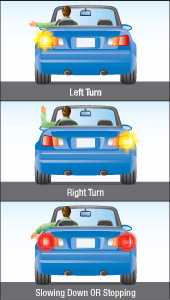Ontario driver's handbook. Ch 1.2. Driving along.
Always be aware of traffic around you as you drive. Develop a routine for looking ahead, behind and from side to side. Check your mirrors every five seconds or so, and check your blind spots by turning your head to look over your shoulder. Keep other drivers out of your blind spot by changing your speed and don't drive in other vehicles' blind spots. This is especially true when driving around large commercial vehicles, as they typically have large blind spots to the sides and back. Be extra careful at dusk and dawn when everyone has difficulty adjusting to the changing light.
Keep a cushion of space around your vehicle and be prepared for the unexpected. Anticipate other drivers movements and make allowances for every possible error. Look well ahead and watch for people in parked vehicles, they may be about to pull out in front of you or to open a door. Watch for smaller vehicles, bicycles and pedestrians.
Steer smoothly
All steering should be smooth and precise. You should do most steering and lane changes without taking either hand off the wheel. You must be able to steer in a straight line while shifting gears, adjusting controls or checking your blind spot.
Picture the steering wheel as a clock and place your hands at nine o'clock and three o'clock.
Use of turn signals and brake lights

Diagram 2-8
Signals tell other drivers what you want to do, alerting them to your intention to turn or stop.
Use your turn signals and brake lights to signal before stopping, slowing down, turning, changing lanes, leaving the road or moving out from a parked position. Give the correct signal well before taking the action and make sure other drivers can see it. Check that the way is clear before you act, just signalling is not enough. Follow the rules for turns, whether left or right, on lane changes and on yields to other vehicles and pedestrians.
If your turn signals and brake lights are not working, use hand and arm signals. The pictures on the previous page show how to make hand and arm signals. When watching for signals made by others, remember that cyclists may signal right turns by holding their right arms straight out.
 Справочник водителя провинции Онтарио. Глава 1.2 Еду по дороге. (Ministry of Transportation of Canada)
Справочник водителя провинции Онтарио. Глава 1.2 Еду по дороге. (Ministry of Transportation of Canada)